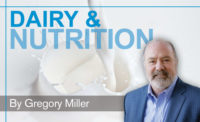The Dietary Guidelines for Americans (DGAs) are updated every five years to provide Americans with a roadmap for healthy eating. They also are the cornerstone recommendations used to develop federal food and nutrition programs.
With revisions for the 2020-2025 DGAs well underway, there are two things to remember: Science matters to the process, and science continues to be on dairy’s side.
Providing evidence
Newly published nutrition science for each five-year revision cycle is an important component of the evidence base for updating DGAs. The National Dairy Council (NDC) always is working toward dairy-related nutrition science that contributes to the body of evidence.
The Dietary Guidelines Advisory Committee is assembled more than a year prior to each new edition to examine the evidence and hear from a variety of experts and stakeholders, including the public, before making a recommendation to the U.S. Department of Health and Human Services and USDA. NDC’s staff shares new dairy nutrition science, data and insights to be reviewed and considered for the next edition of the DGAs.
The departments plan to release the 2020-2025 DGAs — the ninth version — by the end of the year.
Sharing information
NDC is the leading dairy science authority submitting dairy nutrition research through the DGA public comments process. As a checkoff organization, NDC cannot lobby, influence policy or engage with government officials. But it can provide the scientific facts and make sure others throughout the dairy community are aware of the information so they can effectively engage with decision-makers.
Dairy farmers fund hundreds of vital research studies on nutrition, products and environment within each five-year cycle — on topics such as inflammation, protein, digestive health, sustainable food systems, child nutrition and more.
NDC works to keep the research going between each five-year cycle of the DGAs, as well as to make sure that information doesn’t sit on a shelf. NDC educates and communicates new research to multiple audiences, including through traditional and social media, to ensure it is in the public domain. We provide literature reviews and write copious science-based and informative assessments on the health benefits of milk, cheese and yogurt. We highlight dairy’s role in helping to reduce the risk of cardiovascular disease, hypertension and type 2 diabetes, as well as in helping to maintain bone health.
We present the science to the members of the scientific community, who often are consulted during DGA discussions. We host symposiums and speak at national meetings, sharing our insights on timely topics with the research at the core.
Leading into this year’s revisions, we focused on dairy’s role in lowering the risk of inflammation, whole-milk dairy, the birth-through-24-month age range and insights on food label nutrient profiling — to name a few. In all, NDC submitted 13 sets of written comments on 13 different research-based nutrition and health topics. NDC also provided oral testimony during the public process.
Looking ahead
We already are anticipating the research gaps and new research opportunities with an eye toward the 2025-2030 DGAs. Interest in the intersection between health and sustainability has been gaining momentum. Currently, sustainability is not included in the DGAs. NDC will be ready should that change, thanks to the dairy community’s commitment to both human health and environmental sustainability.
NDC will continue to serve the dairy community as a science-based voice for those across our value chain, beginning with the 35,000 U.S. dairy farm families we represent. It’s critical that our collective eyes remain on the importance of science, as groups supporting animal-rights agendas and other special interests lead with ideological beliefs and emotion.
In the end, we are confident that science will prevail when it comes to dietary guidance recommendations.







